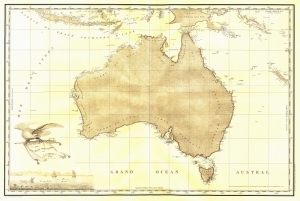
Banished from Bontany Bay
The setting up of Catholic-run schools and a Catholic educational system had a more troubled and opposed start in the colonies of Australia then the Anglican denomination. To look at the beginnings of the Catholic Church schools and educational systems it must be compared with the treatment it was subjected to by the British and Colonial authorities and how this in a way inhibited the beginnings of the organization in the colony. Before the setting up of schools was a priority for the catholic faith in Australia it must be looked at that although largely overlooked in Ireland at the time the penal laws that prohibited the practice of the catholic faith and other protestant dissenters (i.e. Presbyterians) was still in legislation to try and push people to the reformed denominations such as the Church of England or Anglicanism. This is why there was no priest able to travel with the catholic convicts that were to be sent to the newly established colony as laborers. This is a stark contrast compared to the Anglican experience in Australia whose chaplains were basically confidants and advisors to the governors in British colonies and were heavily involved in the establishment of education amongst other areas within the colonies. The establishment of education systems was a major part of the development and foundation of the Catholic Church in Australia and the Irish clergy who helped contribute to its growth.
Rebellion and Banishment – The early days of the colony
The treatment of the Catholic Church by the British government was severely repressed the growth of the Church of the colony and the exclusion of the Catholic clergy left the catholic convicts without spiritual guidance and there was a stark contrast to their protestant counterparts and treated very differently and were not able to actually travel to Australia with the first fleet with the three hundred of so catholic convicts that were amongst the convict population.[1] It would not be until the turn of the century in 1800 and arrived as convicts following the failed uprising in Ireland in 1798. This attempt to block the practice of the catholic faith within New South Wales was reminiscent of the penal laws in Ireland and was an attempt by both the British government back in the old world and can be seen as an attempt by the colonial authorities in the new to perhaps curtail the development of the religion due to its ties with Irish nationalism and fearing a hotbed and haven for Irish dissidents in this part of the world as a number of Irish nationalists would be sent here as convicts. It would take nearly fifteen before he first mass would be officially celebrated in the colony in 1803 by the three convict priests and for a short period it looked as though the relaxing of the British government’s blockade on the catholic church to the colony only lasted a short period of time as the Castle Hill Rebellion involving many of those convicts who had taken part in the 1798 rebellion in Ireland.
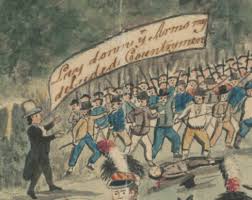
Father Dixon rallying convicts at Castle Hill
The catholic church of Australia often refers to the manner of contempt and suppression that the Catholic Church was subjected to within the colony of New South Wales as the ‘lost generations’ as for three decades the children of catholic convicts were taken from parents and raised within the church of England this was a practice that continued right until the arrival of Father John Joseph Therry an Irish priest and was one of two priests that were the first to be invited Into Australia and can be seen as the establishment of the church within Australia. Their arrival to the new world is where we can see the formation of catholic run schools within the New South Wales. This would not see the end of the animosity the Catholic Church would experience as over the course of the 19th century the Catholic Church would clash with the colonial authorities on several occasions over the topic of education and the running of the schools they had struggled and strived to build and maintain.
Father Therry
There are at least two separate Catholics established in the first years of the 19th century but neither survived very long without support and quickly fell apart and although there was an official visit by a Father O’Flynn in 1817 in which he arrived in secret to the colony and conducted several baptisms, marriages, and masses along with other priestly duties in undisclosed locations until he was caught and sent back to Ireland.[1] That it was not until the arrival of two Irish clergymen, Father John Joesph Therry and Father Phillip Connolly into New South Wales with government approval that there is the significant development in the establishment of a catholic education system within the colony of New South Wales. The first openly sponsored and catholic run school in Australia is Parramatta Marist which was established by the before mentioned Father John Joseph Therry shortly after his arrival and is in fact still in operation to this day some 190 years after the fact. Parramatta Marist would be in the first of ten separate catholic run schools established within the next decade.
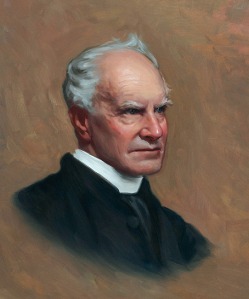
Colour portrait of Father John Joesph Therry
This school was small in size and had a student body that consisted of 24 Catholic and 7 Protestants and one teacher but was met with complications when this teacher was forced to retire early in 1823.[2]Father John Joseph Therry help in the establishment of a catholic school was the beginning of an emergence of other Christian denomination schools to emerge within the colony of New South Wales. Father Therry strived for the bettering the standards of education in the colonies for catholic peoples and is well documented in his collection of letters that were published in the 1920s it shows him to be persistent with the governor asking for better supplies and aid in doing so.[3] This, however, did not succeed most the time. Therry is credited with the founding of the Catholic Church within Australia but as the organization became more structured and organized the British authorities placed the English Benedictines to head the Catholic Church within Australia. There was perhaps a fear that if the Catholic Church was set up by the Irish who moved there and they took over the religious education for the growing catholic youth it may present problems down the line as the fear of radicalization was still in the mind of the British authorities and thus leaving a mainly English catholic religious sect of the religion in charge it may stop the spread of the idea of nationalism amongst the catholic population in Australia. The letters he wrote during his time in the colonies were recorded by Father (Later Archbishop) Eris O’Brien and it is interesting to see the clashes that Father Therry had with the government at the time.Father John Joseph Therry help in the establishment of a catholic school was the beginning of an emergence of other Christian denomination schools to emerge within the colony of New South Wales. Father Therry strived for the bettering the standards of education in the colonies for catholic peoples and is well documented in his collection of letters that were published in the 1920s it shows him to be persistent with the governor asking for better supplies and aid in doing so.[4] This, however, did not succeed most the time. Therry is credited with the founding of the Catholic Church within Australia but as the organization became more structured and organized the British authorities placed the English Benedictines to head the Catholic Church within Australia. There was perhaps a fear that if the Catholic Church was set up by the Irish who moved there and they took over the religious education for the growing catholic youth it may present problems down the line as the fear of radicalization was still in the mind of the British authorities and thus leaving a mainly English catholic religious sect of the religion in charge it may stop the spread of the idea of nationalism amongst the catholic population in Australia.
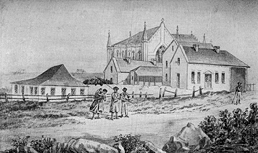
St Marys Cathedral built in the 1830s with the help of Father Therry.
The Irish Jesuits
The teaching of catholic schools like in most of the wider world was left to the various religious orders within the catholic organization and in Australia, this was more of the same. Examples of such organization were the Jesuits and the Christian brothers, the Jesuits had established a presence in the country in the form of members from the Austro-Hungarian Empire in the 1850s and had set up both a church and a school in Sevenhill. This was an important start into the country for the Jesuits but it was not until the arrival of the Irish Jesuits to the colony that would have a profound influence on the educational and social history of Australia, as Irish traditions would become more of an influence within Australian Catholicism[5]. The Jesuits had arrived in Australia at the behest of the Archbishop Goold of Melbourne in order to staff the newly established St. Patrick’s College in Melbourne. With their arrival, the school was able to flourish under their watch and soon by 1866 a second wave of Jesuits would arrive to help with the rapid expansion of St Patrick’s from the original number of 30 to little over a hundred students. The need for an expansion was evident as the school remained a day school throughout its history and the need for there to be a second school established by the Jesuits would again be in Victoria which would become the Jesuits base within Australia and was able to achieve this thanks to a sum left to them at the behest of the Father John Joseph Therry estate.[6] The second school to be established by the Jesuits in the short time they had arrived in the colony would be one that accepted borders known as Xavier College in the town of Kew which was very close to its sister school of St Patrick’s. The Irish influence of the Irish Jesuits was never lost on the established schools.
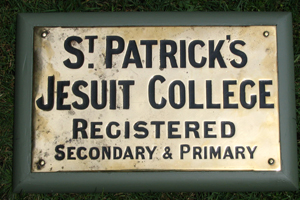
Plaque in honor of the school
Education Act of 1872
The passing of the education act in 1872 within Victoria and was quickly followed by the other surrounding colonies and basically provided free and secular education to the children of Victoria.[7] This act was the first of its kind anywhere in the world and showed the changing viewpoints on religion and education. This presented a problem for the Catholic Church as the withdrawal of State aid presented a great challenge for the Catholic Church which would now have to put a great amount of energy, resources and time into the schools they had fought to establish in the first place and had would have to set up a comprehensive alternative education system in Australia based on the catholic faith. These places would now be largely staffed by members of the Catholic Church such as nuns and priests and entire orders would establish schools of various levels and be responsible for the establishment of. This is quite the contrast to the other Christian religions who did not put nearly the same amount of effort into the preservation of the religious educational system.
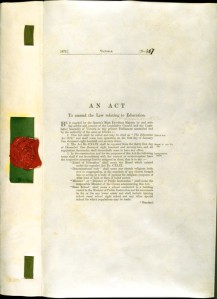
Cover of the Education Act of 1872
The emergence of the Catholic Educational system was turbulent, to begin with and the continued efforts by the British government to try and stop the entry of the priests into the colony was an attempt by them to try and stop the stem of Irish nationalism that could take root in Australia with the continued transport of such dissidents here and the blocking of establishing a catholic run school was an extension of this as it looks like an unsuccessful attempt to try and create a more Anglican society within the colony of New South Wales and this is evident by the preferential treatment the Church of England received and the lack of a catholic presence did nothing but isolate the Catholics here spiritually. Because of this the status the Church of England was given in the establishment of the colony would be overturned by an Irish-born catholic attorney general John Plunkett with the Church Act of 1836.[8]which was paramount in helping not only the catholic church but other Christian denominations gain a better footing in the colony helping them establish better schools and be able to obtain state funding and aid for their school.
Further Reading
[1] Alyson L. Greiner and Terrt G. Jordan Bychkov, Anglo- Celtic Australia: Colonial Immigration and Cultural Regionalism, (Chicago, 2002) p.73
[2]Ashok Rathore, Impact of Christianity on Indian and Australian Societies, (London,2017) p.157
[3] Eris M. O’Brien, Life and Letters of Archpriest John Joseph Therry : Founder of the Catholic Church in Australia, (Sydney,1922) p.67
[4] Eris M. O’Brien, Life and Letters of Archpriest John Joseph Therry : Founder of the Catholic Church in Australia, (Sydney,1922) p.66
[5] David H. Murphy, ‘Irish Jesuit Schooling in Victoria’ in The Irish Journal of Education (Victoria,1991) p.53
[6] David H. Murphy, ‘Irish Jesuit Schooling in Victoria’ in The Irish Journal of Education (Victoria,1991) p.54
[7] Cathy Byrne, Religion in Secular Education What in heaven’s name are we teaching our children in International studies in religion and education, (Boston,2014) p.196
[8] Jan Kockiumbas, The Oxford History of Australia ; Possessions 1770 -1860, (Oxford,2001) p.234